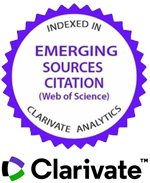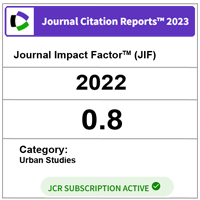The use of amorphous silica-alumina-based additive in the adhesive dry mixes of building materials
DOI:
https://doi.org/10.11113/ijbes.v5.n1.241Keywords:
Dry mixes, Amorphous silica-alumina, Plastic strength, Tile adhesive, Cement.Abstract
Proved the possibility of using amorphous aluminosilicate as a modifying agent for the adhesive dry mixes. Are given the data on the microstructure and chemical composition of the amorphous aluminosilicates. Installed , that the microstructure of the synthetic additives is characterized by particles of round shape, dimensions 5,208-5,704 μm, Also there are particles of elongated shape in size 7.13-8.56 μm. Predominate chemical elements O, Si, Na, S, and Al in quantity 60.69%, 31.26%, 24.23%, 18.69% and 8.29% respectively. Described the character changes in the rheological properties of cement-sand mortar, depending on the percentage of additives. Determined, that the introduction in the cement-sand mortar the additive based on amorphous aluminosilicate leads to higher values of plastic strength. Are given the model of cement stone strength using synthetic additives in the formulation. The results of the evaluation of the frost resistance of cement-based tile adhesives with the use of amorphous aluminosilicates as a modifying additive are presented. In the article is determined the mark on frost resistance of tile glue and frost resistance of the contact zone of tile glue. The evaluation of the performance properties of the layer of tile adhesive on the basis of cement, dry mixes. The calculation of the value of displacement of the adhesive layer made on the basis of the developed recipes cement dry mixes applied to a vertical surface. Experimental data obtained values of displacement tiles relative to the substrate. Described the results of physical and mechanical properties of tile adhesive made on the basis of the developed adhesive dry mix formulations.References
Aiello R., Collela C., Sersale R. (1971). Molecular sieve zeolites, Advances Chem. Ser., 101 51.
Andrejkovicova S., Ferraz L., Velosa A.L., Silva A.S. and Air F.R. (2012). Lime mortars with incorporation of sepiolite and synthetic zeolite pellets, ActaGeodyn. Geomater, 9(1):79–91.
Boldyrev G.G., Hriyanina O.V., (1996) U.S. 1996 Patent #2132545
Broussard L., Shoemker D.P. (1960) Am. Chem. Soc. 82/5, 1041.
DIN EN 12004 (2012). Moscow. Publishing house: Standartinform
DIN EN 12004 (2007). Moscow. Publishing house: Standartinform
Doroshenko Y.M., Shanah J. I. (1989). Рrocesses of structure and properties of cement stone with polymeric modifiers, 15 Szilikatip. esszilikattund. konf.: SILICONF R.l., Budapest, 273-276.
Jenni А., Holzer М., Zurbriggen М., Herwegh, M (2005). Influence of polymers on microstructure and adhesive strength of cementitious tile adhesive mortars, Cement and Concrete Research, 35(1):35-50.
Loganina V.I., Ariskin M.V., Karpova O.V., Zhegera K.V. (2015). Evaluation of crack resistance of the finishing layer based on adhesive dry mixture with synthetic aluminum silicates, Building materials. 1086.
Loganina V.I., Makarova L.V., Tarasov R.V., Ryzhov A.D. (2014) The limy composite binder with the use of the synthesized alumosilicates, Applied Mechanics and Materials. 662:11-14.
Loganina V.I., Makarova L.V., Tarasov R.V., Sadovnikova M.A. (2014) Composition limy binder with the use of the synthesized alumiosilicates for dty construction blends, Advanced Materials Research. 977:34-37.
Loganina V.I., Makarova L.V., Tarasov R.V., Zhegera K.V. (2014) The composition cement binder with the use of the synthesized alumosilicates, Advanced Materials Research. 10223,6.
Loganina V.I., Petukhova N.A., Gorbunov V.N., Dmitrieva T.N. (2009) Prospects for the manufacture of organo-mineral supplements on the basis of domestic raw materials, Proceedings of the higher educational institutions, Building. 936-39.
Loganina V.I., Ryzhov A.D. (2015) Structure and properties of synthesized additive based onamorphous aluminosilicates, Case Studies in Construction Materials 3, 132-136.
Loganina V.I., Zhegera K.V. (2014) Bulletin of BSTU. V.G. Shukhov 5 p 36-41
Loganina V.I., Zhegera K.V. (2014) Evaluating the effectiveness of the use of synthetic aluminum silicates in cement systems, Academic Gazette UralNIIproekt RAASN. 384-87.
Loganina V.I., Zhegera K.V. (2015) Herald of South Ural State University. Series «Construction and architecture». 2(15) p 43-46
Loganina V.I., Zhernovsky V.I., Sadovnikova M.A., Zhegera K.V. (2013) The addition of aluminosilicate-based cement systems, Eastern European Journal of advanced technologies. 5:68-11.
Mirsky Y.V., Mitrofanov M.G., Dorogochinskiy A.Z. (1964) New adsorbents - molecular sieves, Grozny: Chechen-Ingush. 385.
Mumpton F. A. (1999) Larocamagica: Uses of natural zeolites in agriculture and industry, PNAS, 96/73463 – 3470
R Barrer.M., Cole J.F., Sticher H. (1968) Chem. Soc., Inorg. Phys. Theoret. 102475.
Stark U., Reinold M., Muller A. (2003) Neue Methoden zur Messung der Korngrobe und Kornform von Mikro bis Marko, Weimar, 11369 -1380.
Taramasso M., Perego G., Notari В. (1980) Proceedings of the 5th International Conference on Zeolites (Ed.L.V.C.Rees), Heyden, London, 2, 40.
Yiqing F., Lianzhang C. (1991) Effect of aqueous boric acid (H3B03) treatment on catalytic performance of HZSM-5 zeolite catalysts, Shiyou Jiagong, 7/2 44.
Zhegera K.V., Pyshkina I.S., Ryzhov A.D., Zhivaev A.A. (2015) Regional architecture and construction p 64-67.
Downloads
Published
How to Cite
Issue
Section
License
Copyright of articles that appear in International Journal of Built Environment and Sustainability belongs exclusively to Penerbit Universiti Teknologi Malaysia (Penerbit UTM Press). This copyright covers the rights to reproduce the article, including reprints, electronic reproductions or any other reproductions of similar nature.
Authors who publish with this journal agree to the following terms:
- This Journal applies Creative Commons Licenses of CC-BY-NC-SA
- Authors retain copyright and grant the journal right of publication with the work simultaneously licensed under a Creative Commons Attribution License that allows others to share the work with an acknowledgement of the work's authorship and publication in this journal.
- Authors are able to enter into separate, additional contractual arrangements for the non-exclusive distribution of the journal's published version of the work (e.g., post it to an institutional repository or publish it in a book), with an acknowledgement of its publication in this journal.
- Authors are permitted and encouraged to post their work online (e.g., in institutional repositories or on their website) prior to and during the submission process, as it can lead to productive exchanges, as well as earlier and greater citation of published work (See The Effect of Open Access).







